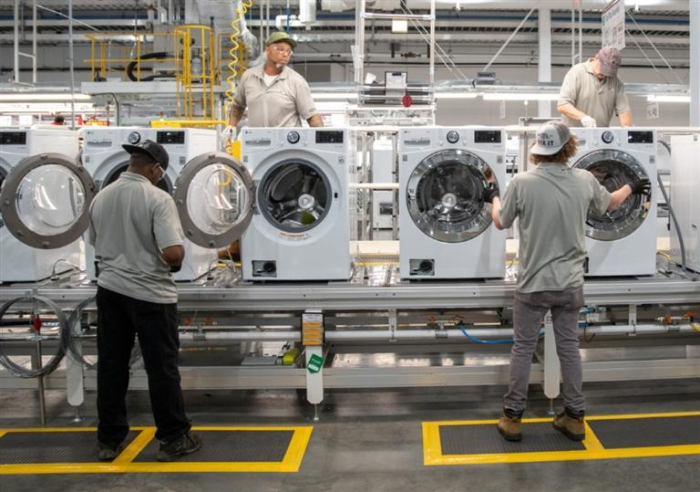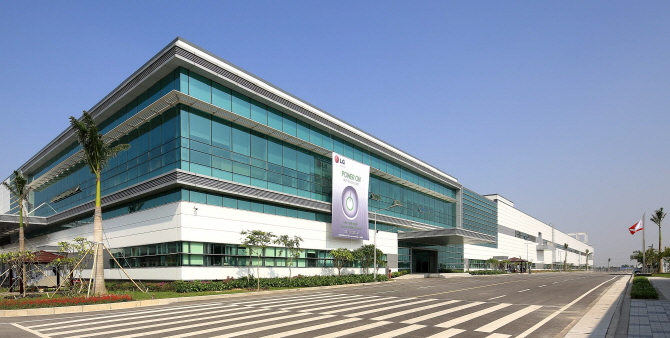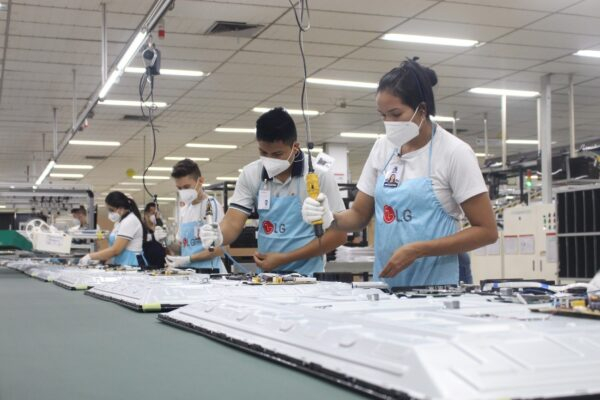-
KOSPI 2577.27 -2.21 -0.09%
-
KOSDAQ 722.52 -7.07 -0.97%
-
KOSPI200 341.49 +0.02 +0.01%
-
USD/KRW 1396 -2.00 0.14%
LG Electronics expands overseas appliance plants as it exits phone business
Business restructuring
LG Electronics expands overseas appliance plants as it exits phone business
LG is expected to overtake Whirlpool as the top appliance maker this year with facility spending up 41% from 2020
By
Jun 02, 2021 (Gmt+09:00)
3
Min read
News+

LG Electronics Inc. is expanding its overseas production facilities as the South Korean home appliance giant is shifting gears toward new growth drivers such as telematics after dropping its money-losing mobile phone business.
With the global economy recovering fast from the pandemic, LG is ramping up production plants in four of its major markets – the US, Brazil, Vietnam and Saudi Arabia – to meet pent-up consumer demand.
According to industry officials on June 2, LG Electronics last month won approval from the Brazilian government for its plan to invest $62 million to expand its Manaus plant located in the northwestern Brazilian state of Amazonas.
The company is expanding the facility as it is shutting down the mobile phone production line in Taubate and relocating the monitor and laptop production lines there to the Manaus plant.
Once the new laptop and monitor line is up and running this summer, LG Electronics will become one of the largest employers in the state of Amazonas, with total local hiring of 2,200 workers.
The Korean company entered Brazil in 1995 and has been expanding its presence in the local market based on its production plants in Manaus and Taubate.
The move comes in line with LG’s decision in April to exit from the mobile phone business, which has accumulated operating losses of 5 trillion won ($4.5 billion), putting its focus on automotive parts and robotics as well as its flagship home appliance business.

SWITCHING VIETNAM’S SMARTPHONE PLANT TO FRIDGE FACTORY
As part of the decision, LG Electronics is switching its largest overseas center of smartphone production in Haiphong, Vietnam to a plant for home appliances, including refrigerators.
The company plans to complete the transition of production facilities and employee transfers in Vietnam by the end of this year.
In the US, one of LG’s largest overseas markets, the company said it is spending $20.5 million to ramp up capacity at its washing machine plant in Tennessee. The expansion at the plant with an annual production capacity of 1.2 million washers comes after the company posted double-digit sales growth in the North American market over the past few years.
In Saudi Arabia, where LG is running an air conditioner joint venture with a local company, it plans to use industrial robots and artificial intelligence systems to cut costs and improve productivity.
“Most of our overseas home appliance production lines are running at their highest operating levels in five years. We need drastic upgrades and expansion there,” said an LG Electronics official.
Earlier this year, the company set its 2021 facilities investment at 3.62 trillion won, up 41% from the previous year.
Separately, its affiliate LG Innotek Co. said it is investing 1.55 trillion won on expanding its facilities and upgrading equipment this year. LG Innotek is a major camera module supplier for Apple Inc.’s iPhones.
LG Group, Korea’s fourth-largest conglomerate, said in mid-May that it will spend about 120 billion won over the next three years to establish a massive high-performance computing infrastructure for advanced artificial intelligence as part of its group-wide digital transformation.

TELEMATICS, A NEW GROWTH DRIVER
One of the new growth drivers of LG is the auto component and telematics business.
LG is the world’s second-largest player in the fast-growing telematics market after German auto parts maker Continental AG. LG Electronics controls 24.8% of the telematics market as of the first quarter of this year.
LG has earmarked 613.8 billion won in research and development (R&D) spending for its vehicle component solutions (VS) division this year as it supplies more of its products to automakers such as GM, Toyota and BMW.
LG Electronics has also ventured into automotive parts related to electric vehicles and self-driving since it acquired Austria-based premium lighting systems maker ZKW in 2018.
Analysts said LG will likely post its best-ever sales revenue for its home appliance business this year, overtaking Whirlpool Corp. as the world’s top manufacturer of home, kitchen and laundry appliances.
The company posted record overall sales and operating profit in first quarter for this year, boosted by strong sales of a suite of high-class consumer goods sold under the LG Objet Collection brand.
Write to Su-Bin Lee at lsb@hankyung.com
In-Soo Nam edited this article.
More To Read
-
May 25, 2021 (Gmt+09:00)
-
Apr 29, 2021 (Gmt+09:00)
-
 Revenue rankingsLG Electronics set to overtake Whirlpool as top home appliance maker
Revenue rankingsLG Electronics set to overtake Whirlpool as top home appliance makerApr 20, 2021 (Gmt+09:00)
-
 Auto componentsLG Electronics eyes growth potential in US auto parts market
Auto componentsLG Electronics eyes growth potential in US auto parts marketMar 09, 2021 (Gmt+09:00)
-
 Future mobilityLG Electronics, Magna to launch $1 bn EV gear JV
Future mobilityLG Electronics, Magna to launch $1 bn EV gear JVDec 23, 2020 (Gmt+09:00)




